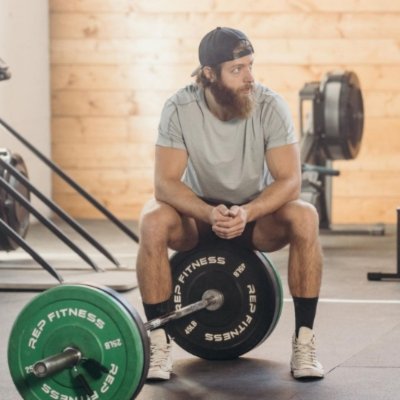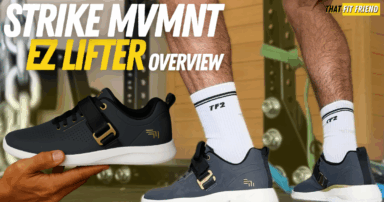The chest supported dumbbell row is one of my favorite back exercises and for good reason. It’s a low-skill exercise that can be great for building the lats and upper back.
Whether I’m home and training regularly or traveling, there’s a good chance I’ll have chest support dumbbell rows programmed. In my coaching opinion, if you’ve never tried chest-supported dumbbell rows, then you’re missing out.
The chest supported dumbbell row can be a great exercise for focusing on and isolating the back muscles without putting a ton of stress and load on the spine.
How To Properly Perform These
Step 1: Set Up Your Bench Properly
The first step to nailing chest support dumbbell rows is to make sure you’re setting up your adjustable bench correctly. I typically coach and suggest setting your bench up 1 or 2 notches.
Every bench is different so you’ll have to play with the benches you have available. As a rule of thumb, we want the bench to have a low incline so the row hits more lats and isn’t super vertical. Think 30-40 degrees.
Step 2: Grip the Bells, Set, and Row
Once you’ve set your bench, you’ll then grab each dumbbell one at a time and ensure you have a set and stable position on your bench. I’d suggest digging the toes into the ground so you don’t slide around while rowing.
Let the arms hang before initiating your row and try to “feel” a stretch on the lats and back when doing so. Once you feel this stretch, brace accordingly for the intensity you’re using and start your row.
Step 3: Drive the Elbows Back, Squeeze, and Repeat
To start your row, think about bringing the elbows back instead of shooting them straight up. I like to cue, “Pretend as though I’m standing behind you pulling your elbows back with strings.”
This will help keep your row focused on the lats, rhomboids, and upper back muscles versus only hitting the upper back muscles. For an added tip to ensure you’re hitting the right muscles, avoid shrugging upwards a ton while rowing.
Why Perform These
When coaching and programming the dumbbell row, there are three key benefits that I try to keep in mind with this exercise. By recognizing the benefits of this exercise you can be more strategic with your programming.
1. Great for Limiting Spinal Loading
The first benefit that comes along with performing chest supported dumbbell rows is that it can be a good back exercise when the goal is limiting overall spinal loading and stress.
If you’re deadlifting, squatting, barbell rowing, and doing other exercises that put a lot of stress on the spine but still want to get some isolated back work the chest supported dumbbell row can work really well.
I’ll typically program chest supported dumbbell rows towards the end of back-focused workout days because it’s a great variation for chasing a pump while not killing your spine regarding direct loading and accumulating a ton of fatigue.
2. Awesome Sub When Equipment Isn’t Available
Another benefit of chest supported dumbbell rows is their ability to give you a similar stimulus to a chest supported row machine when equipment isn’t available.
The chest supported row machine is great for getting heavy and hitting the back but not every gym has this piece of equipment. The chest supported dumbbell variant will replicate this machine and you only need dumbbells and a bench to do them.
On top of this, I actually find that chest supported dumbbell rows can give you a little more variance compared to some machines.
Not every chest supported row machine is built well regarding resistance profiles and if you want to bias your intent by changing elbow position and rowing mechanics, then you can oftentimes do that easier with chest supported dumbbell rows.
3. Useful for Isolating Different Back Muscles
The final benefit that I often discuss that comes with chest supported dumbbell rows is their ability to isolate and hit different back muscles in a seamless and low-skill means.
For example, if you’re performing this exercise like normal and keeping the elbows somewhat tight to the body then you’ll have a nice blend of lats and upper back muscles.
However, if you wanted to bias the upper back muscles and traps more then you could bring your elbows out and get a nice stimulus for these muscle groups without changing too much with your form.
When I’m teaching lifters and athletes how to bias different muscles by changing joint angles, especially in the context of rowing, I find that the chest supported dumbbell row can be a fantastic tool for doing so.
Muscles Worked
When performing chest supported dumbbell rows the muscles you’ll be training will be heavily dictated by your form and intent of doing them. Below I’ll cover the muscles worked when performing traditional chest supported dumbbell rows.
Again, if you wanted to change the intent of this exercise and focus more on something like the upper back, then you’d want to explore changing your elbow position.
Mistakes to Avoid
With chest supported dumbbell rows the devil’s in the details. There are two common mistakes that I’ll see lifters make with this back exercise that can cut into their gains.
Mistake 1: Shrugging Too Much Before Rowing
Ther first mistake that I see lifters make, and this is a mistake I see with exercises like the dumbbell row, too, is shrugging too much before or during the row.
If you’re finding yourself shrugging a lot while doing this exercise then you’ll be taking away from the work that you’re trying to give the lats. This will also limit the range of motion you’re working through and change the intent of the exercise.
The Fix: To avoid shrugging your chest supported dumbbell rows it all starts with your cueing. Think as though you’re rowing the elbows down and then back when you perform this exercise.
If I were coaching you, I’d cue you to pretend that there’s a puppeteer standing behind you and that your elbows are on strings. As the puppeteer pulls, let the elbows lead versus shrugging and using a lot of biceps to row the dumbbells.
Mistake 2: Setting the Bench Up Too High
As my dad always said, “If you’re going to do it, you might as well do it right.” Another mistake that I see lifters make with the chest supported dumbbell row is setting up their bench wrong.
It’s important to maske sure you’re not setting your bench up too high regarding its incline. Most benches will be best set to the first or second notch regarding their ability to incline.
The Fix: When in doubt, start lower then work your way up. If you notice that your upper back is “feeling” most of this exercise and there’s virtually no feeling with the lats then your bench is likely too high.
Remember, the goal for a traditional chest supported dumbbell row is to get a relatively horizonal row and not a close to vertical row. There could be a time and place for a higher bench setup, but for most cases, lower is better. Think 30-45ish degrees of incline.
Programming Considerations
When programming chest-supported dumbbell rows, I’d suggest focusing on two programming elements to get the most out of this exercise. These two elements include volume and tempo.
- For General Strength: 3 x 6-8 reps at a 1-2 RIR intensity. Use weight as your progression each week.
- For Hypertrophy: 3 x 12-15 with a 3-second concentric, 1-sec hold at the top, and 3-second eccentric at 9/10 effort. Use load and tempo as your means of progression each week and take your top set to failure.
Your usage and programming with chest supported dumbbell rows should be contextual on your needs. The above is two general ideas for programming so don’t be afraid to play with other set and rep schemes.
Takeaway Thoughts
The chest supported dumbbell row is an awesome exercise for lifters and athletes wanting to build their backs. This exercise is also great because it can limit how much spinal loading you’re accumulating while hitting the lats and upper back muscles.
If you’re new to this variation, start lighter and work on using a smooth tempo while executing reps with the form you’re after.
If you have additinoal questions about the chest supported dumbbell row, drop a comment below or reach out to me personally via Instagram (@jake_boly or @that_fit_friend).
















Add a Comment